168直播极速赛车一分钟正式官网 Give your customers data that can be trusted
CALA is an internationally recognized leader in providing the highest-quality accreditation of laboratories.
一分钟开奖极速赛车记录大全 CALA Services
Accreditation
A means of determining the technical competence of laboratories to perform specific types of testing, measurement.
Training
CALA Training offers courses to members and non-members in a variety of options.
“The amount and quality of resources that CALA offers is invaluable and has played a critical role in making us the first ISO/IEC 17025:2017 accredited Malt Lab in North America.”
— Mawill Rodriguez , North American Quality Assurance Manager
全国一分钟统一极速赛车开奖直播 CALA News and Articles

New Calibration Assessment Partnership for CALA

How Robust is Your Laboratory's Business Continuity Plan?
168赛车官方智能一分钟预测计划推荐 Find a CALA-Accredited Lab
The laboratories included in the Directory of Accredited Laboratories have achieved the recognition conferred by the granting of laboratory Accreditation by CALA.
一分钟开奖极速168赛车记录 Get Involved
There are many ways in which you can become a part of CALA.
Become a Member
CALA membership is open to individuals, user groups, institutions, consultants, industrial organizations, regulatory agencies, laboratory equipment suppliers, and others interested in the work being carried out in environmental analytical laboratories.
Become a Volunteer
Volunteering with CALA provides you with an exciting opportunity to meet new people, and work with and learn from committed industry professionals. Doors will open for you, as you become part of a network of experts with similar interests and challenges!
